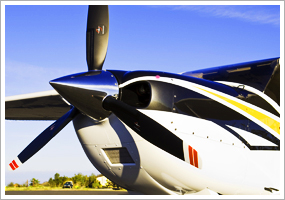| The following stories from the April 9, 2010, edition of AOPA ePilot were provided to AOPA members who expressed an interest in the particular subject areas. Any AOPA member can receive information tailored to their areas of interest by updating their preferences online. TRAINING TIPsProps and safety
Have good examples been set for you about prop safety? Resolve to set good examples for others, including pedestrians on the ramp and your future passengers. They’ll be placing their trust in you to keep them from harm.
That’s why your prop awareness is critical and will be closely evaluated. “One way to make a quick appraisal of a pilot's safety consciousness before ever leaving the ground is to watch how he behaves in the vicinity of the propeller. Does he use it as a leaning post while posing for a photograph or when chatting up the line crew during fueling? Does he horse the airplane around by the prop hub rather than dig the towbar out of the baggage compartment? Does he really look at the prop during preflight, and know what he's looking for?” wrote Dan Namowitz in the October 2003 Flight Training Accident Analysis column, which profiled mishaps associated with prop-safety lapses.
You’ll find pointers on working safely around the propeller, plus tips on spotting prop problems in the AOPA Air Safety Foundation’s Safety Advisor, “ Propeller Safety.”
For example, can you diagnose a hot mag during engine checks? The term refers to an ungrounded magneto—a condition you check for during every runup. Don’t defer action if you detect the problem. “You need to report this to an airframe and powerplant (A&P) mechanic as soon as possible because this is a dangerous situation. If someone happened to turn the propeller by hand, it’s possible the engine would start,” explains the answer to the Final Exam question in the Feb. 13, 2009, ePilot Flight Training Edition .
This may surprise you, but a well-maintained prop is not only safe and efficient—its smoothness can reduce pilot fatigue (see the Feb. 13, 2004, “ Training Tip.” So don’t just holler “clear prop” and start the engine. Observe every variety of prop safety on every flight. TRAINING PRODUCTSBose headset saleIf you’ve ever wanted a Bose X headset, now is the time. Marv Golden is offering the high-end headset new for $845 with free shipping. That’s a savings of more than $150.
Note: Products listed have not been evaluated by ePilot editors unless otherwise noted. AOPA assumes no responsibility for products or services listed or for claims or actions by manufacturers or vendors. FINAL EXAMQuestion: What is wind shear, and how can it affect me during flight? Answer: Wind shear is a rapid change in wind speed and/or direction. There are several causes, including temperature inversions, frontal zone passages, and thunderstorm activity. Wind shear can happen at any altitude; however, one of the most dangerous times to encounter this phenomenon is during the landing or takeoff phase when the aircraft is at a low altitude and low airspeed. An extreme type of wind shear is a microburst. Microbursts are small-scale intense downdrafts that spread out in all directions once reaching the ground. This causes both vertical and horizontal wind shear that can be particularly dangerous to aircraft, especially at low altitudes. An encounter like this during landing might exceed an aircraft’s ability to maintain a stable descent rate, causing it to impact terrain short of the runway. To learn more about this potentially hazardous weather condition, read “ The Weather Never Sleeps: Ill Wind.” Got a question for our technical services staff? E-mail [email protected] or call the Pilot Information Center, 800/872-2672. Don’t forget the online archive of “Final Exam” questions and answers, searchable by keyword or topic. |



